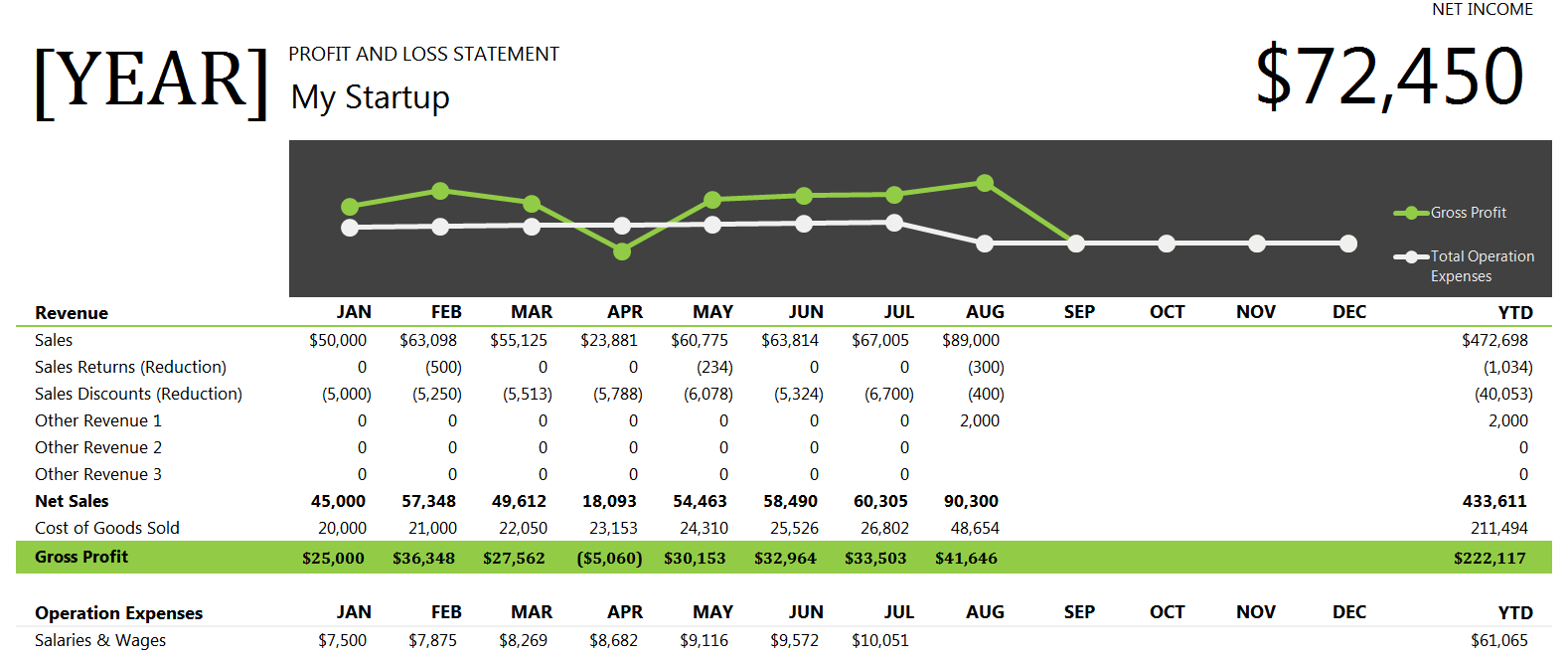
One of the first and most important steps to take before you launch your startup is to have an accountant create pro forma financial statements—based on certain assumptions and projections—to verify that your company makes financial sense.
The three pro forma financial statements I’m referring to are the income statement, cash flow statement and the balance sheet.
When reviewing your company’s financial statements, be on the lookout for these five fatal financial flaws:
-
Negative Cash
Your cash flow statement provides information about your gross receipts and gross payments for a specified period of time. In this statement, the bottom line of every column is always labeled “Cash at End of Period.” Based on your assumptions, it tells you how much cash you will have in your company’s bank account at the end of a specified period. No entry in this row can be negative.

Photo: Cash Flow Statement example If a column has a negative value, you must adjust assumptions. For example, possibilities include, but are not limited to: a) get a loan b) raise money in an investment round c) sell more product or d) decrease expenses.
What you cannot do is just launch and hope that things will work out. Hope is not a strategy. Many things will change once you launch, but you have to at least start with a plan that has a fighting chance.
-
Negative Gross Profit
On your income statement (P&L), near the top of every column will be line items for revenue, cost of goods sold, and gross profit. Gross margins indicate how efficient you are at acquiring and using raw materials for products. Different industries tend to experience radically different gross margins based on (a) inherent cost of goods sold, and (b) level of price competition.

Photo: Income Statement example You can tolerate a negative gross profit in the first year while you figure out pricing, find optimal suppliers, and hone manufacturing and internal processes. However, by year 2, you had better have a positive gross profit. New companies rarely emerge in industries where gross margins are low. The obvious reason being that investors will not likely see a return on their investment based on an ROE calculation.
You can increase gross margins by: a) decreasing cost of raw materials, b) outsourcing, insourcing, offshoring or onshoring c) increasing prices or d) changing the product.
-
Insufficient Cash from Operations
Your cash flow statement captures cash flowing in or out of the company that result from core business operations. The bottom line of every column on the top third of this statement tells you—based on assumptions—how much cash you are generating without the contributions of loans, investments, or sale of property.
Almost all startups experience negative cash from operations for the first few years. During this time, they rely on infusions of cash from external sources such as investments or loans. However, a successful company must at some point be self-sufficient.
It is possible that a high-growth company with a huge market could plan to stay on a high-growth trajectory for many years and continue to need capital infusions to fund its growth. Yet the best way to describe this fatal flaw is to ask yourself if the cash from operations would be positive if financing is set to zero.
-
Current Ratio Less than One
On the annual balance sheet, divide current assets by current liabilities for each year. This current ratio gives you a pretty good indication of whether your company will be able to pay off debt when due. A value less than 1.0 indicates that you are going to have problems.

Photo: Balance Sheet example As your company evolves, your current ratio should become (and remain) above 1.2. If your current ratio is less than zero, it means your current assets are negative (current liabilities can never be negative), so this is equivalent to fatal flaw 1.
-
No Profit
On your annual income statement (P&L), near the bottom of every column, is a row labeled “EBITDA,” short for earnings before interest, taxes, depreciation, and amortization. You can think of it as profit without some of the “noise”.
Most startups experience negative EBITDA for the first one or two years, and that is okay. In fact, it is highly unlikely to have positive EBITDA during those first few years. However, by year three or so, EBITDA should be positive, and stay positive for the remaining years.
Although many dozens of potential problems can be detected in advance by examining the pro forma financial statements, the above five conditions are easy to detect and are almost always fatal for your company if they are not fixed. If you find them to be present in your company’s financial statements before you launch, don’t launch! Instead, fix your plan.
After you fix the plan, and know that it is possible to succeed, then launch your startup.
This article has been edited and condensed.
Dr. Al Davis has published 100+ articles in journals, conferences and trade press, and lectured 2,000+ times in 28 countries. He is the author of 6 books, including the latest, Will Your New Start Up Make Money? He is the co-founder and CEO of Offtoa, Inc., an Internet company that assists entrepreneurs in crafting their business strategies to optimize financial return for themselves and their investors. Dr. Davis has also founded or co-founded five other startups, including a software business acquired by IBM in 2003 and a company that went public in 1995, later acquired by Titan in 2001, and subsequently acquired by L-3 Communications in 2003. Not all of his ventures have been so successful which allows him to be candid and knowledgeable about the highs and lows of being an entrepreneur. Connect with @Offtoa on Twitter.
© YFS Magazine. All Rights Reserved. Copying prohibited. All material is protected by U.S. and international copyright laws. Unauthorized reproduction or distribution of this material is prohibited. Sharing of this material under Attribution-NonCommercial-NoDerivatives 4.0 International terms, listed here, is permitted.




